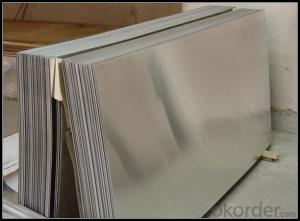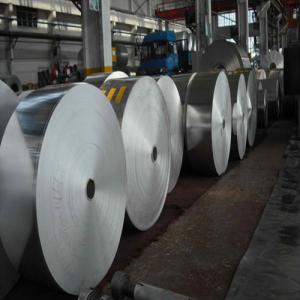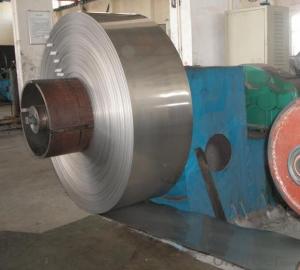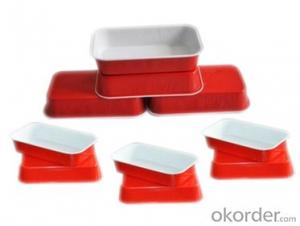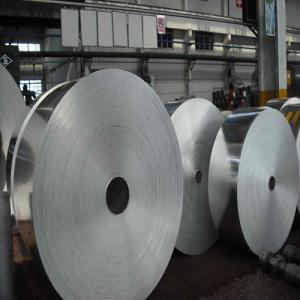Aluminum Batten Strips in Roll Shutter with Different Aluminum Coils
- Loading Port:
- Tianjin
- Payment Terms:
- TT OR LC
- Min Order Qty:
- 1 m.t.
- Supply Capability:
- 4999 m.t./month
OKorder Service Pledge
OKorder Financial Service
You Might Also Like
Specification
1. Specification of Aluminum
1) Alloy | 1050, 1060,1100, 3003 3004 3105 3005 5005 5052 etc |
2) Temper | O/H12/H14/H1/H18/H32/H34/H36/H38//H111/H112/H116/H321/T6/T651/T3/T351 etc |
3) Thickness | 0.1mm to 6mm |
4) Width | 20mm to 3300mm |
5) Coil weight | 100kgs to 6 tons depends on actual requirement |
6) Core material | Aluminum alloy |
7) Coil Inner diameter | 76mm, 152mm,or as required |
2. Application of Aluminum
(1).Interior: wall cladding, ceilings, bathrooms, kitchens and balconies, shutters, doors...
(2).Exterior: wall cladding, facades, roofing, canopies, tunnels,column covers , renovations...
(3).Advertisement: display platforms, signboards, fascia, shop fronts...
3. Feature of Aluminum
Shares in the Rio Tinto Group -- a British-Australian mining conglomerate -- rose 4.4 percent Thursday to post its biggest two-day advance in more than three years, as aluminum prices hit a three-month high. The company's stock has gained 8.8 percent since Wednesday. BHP Billiton, the world’s largest miner, rose 5.3 percent during morning trade in Sydney.
Be free from Oil Stain, Dent, Inclusion, Scratches, Stain, Oxide Dicoloration, Breaks, Corrosion, Roll Marks, Dirt Streaks and other defect which will interfere with use
4. Certificate:
SGS and ROHS(if client request, paid by client), MTC(plant provided), Certificate of Origin(FORM A, FORM E, CO), Bureau Veritas and SGS (if client request, paid by client), CIQS certificate
5. Image of Aluminum


6. Our Service
1. Reply your enquiry in 24 working hours. |
2. OEM, buyer design, buyer label services provided. |
3. Exclusive and unique solution can be provide to our customer by our well traned and professional engineers and staffs. |
4. We can provide free sample for your check |
5. We have the certification of ISO 9001 |
6. Timely delivery |
7. Special discount and protection of sales area provided to our distributor. |
8. Good after-sale service. |
7. FAQ
Q: What is the produce prase? | ||||
A: Normally it would be 40days after received your deposit. | ||||
Q: Can you provide free samples? | ||||
A: Yes, free samples will be sent to you on freight at destination. | ||||
Q: Can I get your latest catalogue? | ||||
A: Yes, it will be sent to you in no time. | ||||
Q: What is the MOQ? | ||||
A: 3 tons | ||||
Q: What are your payment terms? | ||||
A: We accept L/C, D/A, D/P, T/T, West Union,etc. |
- Q: What types of aluminum are known for their high strength and resistance to wear and tear?
- <p>Yes, certain types of aluminum alloys are known for their exceptional strength and resistance to wear and tear. 7075 aluminum, for instance, is one of the strongest aluminum alloys, often used in aerospace and automotive applications due to its high strength-to-weight ratio. Another example is 6061 aluminum, which is commonly used in structural applications because of its good mechanical properties and resistance to corrosion. These alloys achieve their strength through the addition of elements like copper, magnesium, and zinc, which enhance their properties for specific industrial uses.</p>
- Q: Is it good to drive a wheeled excavator or an aluminum belt?
- How many people do you say you drive, or do you drive more tanks? However, the western development is over, the excavator is not fragrant. Go to the second-hand Internet to see the excavator is very cheap. Take mine. Thank you。。。
- Q: Is it possible to use aluminum strips for the purpose of covering the interior walls of a building?
- <p>Yes, aluminum strips can be used for interior wall cladding. They are known for their durability, low maintenance, and resistance to moisture and corrosion, making them suitable for various interior applications. Aluminum strips are lightweight, easy to install, and can be used in both residential and commercial settings. They come in various finishes and colors, allowing for customization to match the desired aesthetic. However, it's important to ensure proper installation and adherence to building codes and safety standards.</p>
- Q: Describe the process of manufacturing aluminum strips.
- <p>Aluminum strips are made through a series of processes starting with the production of aluminum ingots. The ingots are heated and then rolled into thin sheets in a hot rolling mill. This process reduces the thickness of the aluminum and elongates it into a strip. The hot-rolled strips are then cooled and may undergo further cold rolling to achieve the desired thickness and hardness. After rolling, the strips may be annealed to improve their ductility and strength. The final step includes cutting the strips to the required length and packaging them for distribution. This process ensures that aluminum strips have the desired properties for various applications such as construction, automotive, and aerospace industries.</p>
- Q: Can the high frequency of aluminum band replace the high frequency of professional high-power loudspeaker box?
- Can not be replaced, professional speakers generally use the horn loudspeaker, the sound directivity and speaker sensitivity are high, with a sound tweeter transient, clear, but the power and sensitivity of traditional voice Miss horn loudspeaker
- Q: How much is the small aluminum belt excavator?
- There are many types of small tracked vehicles, but I don't know which one you want.
- Q: What are the various classifications of aluminum strip based on their properties and applications?
- <p>Aluminum strips are classified into different grades based on their alloy composition, mechanical properties, and applications. Common grades include 1000 series (99% pure aluminum), 3000 series (aluminum-manganese alloys), 5000 series (aluminum-magnesium alloys), and 6000 series (aluminum-magnesium-silicium alloys). Each grade has specific characteristics, such as corrosion resistance, formability, and strength, making them suitable for various industries like construction, automotive, and packaging.</p>
- Q: What are the safety standards or guidelines that should be followed when using aluminum strips?
- <p>Yes, there are safety standards for using aluminum strips. These include ensuring that the aluminum is of the correct grade for its intended use, following guidelines for handling and storage to prevent contamination or damage, and adhering to regulations regarding worker safety, such as wearing appropriate personal protective equipment. Additionally, it's important to comply with local and international standards like ASTM or ISO specifications for aluminum products. Proper ventilation should be maintained during processing to avoid inhalation of dust or fumes, and safety measures should be taken to prevent fires, as aluminum can be a fire hazard in certain conditions.</p>
- Q: Which brand of aluminium band for dry transformer?
- Personal feeling 1070 should be better, because a higher proportion of content, electrical conductivity must be better, but at present, the market is indeed everyone's use.
- Q: Is it possible to utilize recycled aluminum to fabricate new aluminum strips?
- <p>Yes, recycled aluminum can be used to make new aluminum strips. Recycling aluminum is an efficient process that conserves energy and resources. The recycled aluminum is melted down and then reformed into new shapes, including strips. This process is not only environmentally friendly but also cost-effective, as it requires less energy compared to producing aluminum from raw materials. The recycled aluminum strips maintain the same properties as those made from new aluminum, making them suitable for various applications.</p>
Send your message to us
Aluminum Batten Strips in Roll Shutter with Different Aluminum Coils
- Loading Port:
- Tianjin
- Payment Terms:
- TT OR LC
- Min Order Qty:
- 1 m.t.
- Supply Capability:
- 4999 m.t./month
OKorder Service Pledge
OKorder Financial Service
Similar products
Hot products
Hot Searches
Related keywords
